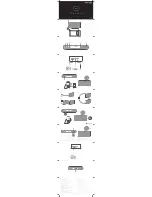
Instruction Manual
PES1513 Electric Power Unit - V1.1
www.durapac.com
Page 6 of 8
Dirt, sand, etc. will quickly ruin any hydraulic system. Ensure that couplings are clean and
free of foreign matter. After each use, clean couplings and attach dust caps.
Maintenance is required when wear or leakage is noticed. Periodically inspect all
components to detect any problem that may require service and maintenance.
6.1
Adding Hydraulic Fluid
WARNING: Always add oil with cylinders fully retracted (or extended, if pull cylinders) or
the system will contain more oil than the reservoir can hold
6.1.1
Depressurise and disconnect hydraulic hose from application/cylinder.
6.1.2
With the power unit in its upright, horizontal position, remove the air vent
plug located on the top plate of the reservoir.
6.1.3
Use a small funnel to fill the reservoir to within 19mm (3/4") of the opening.
6.1.4
Bleed air from system if necessary.
6.1.5
Wipe up any spilled fluid and reinstall the air vent plug/reservoir cap.
6.2
Bleeding Air from the System
6.2.1
Repeat Steps 6.1.1 to 6.1.3 (above), if required.
6.2.2
Invert cylinder and place at a lower level than the power unit reservoir.
6.2.3
Extend and retract the cylinder several times without putting a load on the
system. Air will be released into the power unit reservoir.
6.2.4
Recheck oil level after removing air.
6.3
Changing Hydraulic Fluid
For best results, change fluid once a year or every 300 hours of use
6.3.1
Repeat Steps 6.1.1 to 6.1.2 (above).
6.3.2
Pour used fluid into a sealable container.
6.3.3
Repeat Steps 6.1.3 to 6.1.5 (above).
6.3.4
Dispose of fluid in accordance with local regulations.
6.4
Storage
6.4.1
When not in use, depressurise and disconnect the power unit from the
application.
6.4.2
Wipe clean thoroughly and store in a clean, dry environment. Avoid
temperature extremes.
6.4.3
For transportation or long storage, replace the air vent plug with shipping
plug.
6.4.4
Shield power unit with a protective cover.


























